Often overlooked when considering the 4C’s of diamond buying, Polish and Symmetry are two key aspects when looking at diamond quality. They are grouped on a grading certificate under ‘Diamond Finish’ and are actually a feature of the cut quality of a diamond.
Polish and Symmetry should not be an after-though while searching for a diamond, rather they should be considered as a component of the cut quality to be viewed in conjunction with the table size and depth, as well as crown and pavilion angles. Although should not be the deciding factor when buying your diamond, an understanding of these polish and symmetry characteristics will help you empower you to make better choices when shopping for your diamond.
Symmetry – Symmetry refers to how precise the shape, overall outline, alignments and placement of individual facets.
Common Polish Features on a Diamond
All cut diamonds, with the exception of flawless diamonds, bear the remnants of polishing marks. Diamonds with an ‘excellent’ polish grading will display polish lines that are incredibly fine, so fine that they can only be seen under a high magnification and when viewed at a specific angle. Polish lines are not the only characteristics that a gemmologist will look for when evaluating a diamond to give a polish grade. Other characteristics include:
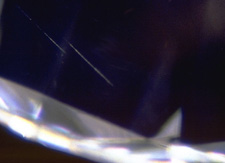
Scratch – Transparent looking white line on the diamond’s surface.

Nick – Minute notches found on facet or girdle junctions.
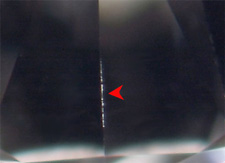
Abrasion – Caused by a series of nicks at facet junctions.
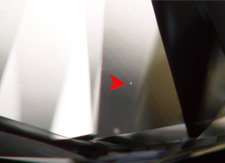
Pit – A small opening usually cause by pinpoint inclusions falling out of their pockets during polishing.
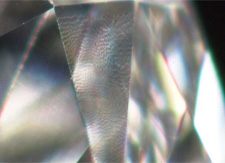
Lizard skin – Bumpy looking texture on a diamond’s surface.
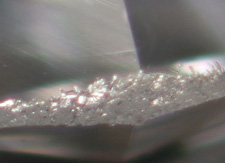
Rough girdle – An unpolished girdle left in its original state after bruting.
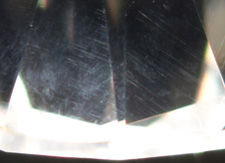
Burn marks – A layer of whitish haze typically caused by high temperatures from a jeweler’s torch or polishing wheel.
All images provided by https://www.gia.edu/
Polishing features do not penetrate the surface of a diamond and therefore are examined as separate entities from clarity characteristics (inclusions).
Reputable diamond vendors will aim to offer their customers a Very Good or Excellent polish grading, meaning these polishing marks will not be visible to the naked eye. A poor-quality stone may be re-polished to increase a polish grading, however in doing so some of the carat weight will be lost. It is often vintage diamonds that are re-polished to bring them up to modern standards of brilliance and fire.
GIA Polish Grading
The GIA grade polish on a scale from Excellent to Poor. The specific features are evaluated by experts under a 10X magnification to determine which grading the diamond will get.
Understanding Diamond Symmetry
When it comes to diamond symmetry, it is actually very rare to find mistakes or accidental flaws occurring. Instead, a diamond cutter will make the conscious choice to sacrifice symmetry in favour of a getting the maximum yield from the rough. Some carat weights (for example, 1.00ct) are more desirable than others, so the cutter will aim for these weights even if it means taking a rough with the potential to be Excellent and cutting it to a standard of Good.
Gemmologists will look at three issues when it comes to symmetry:
- Size and shape of the facets
- Alignment of the crown and pavilion
- Placement of the culet sits compared to the table
Using a round brilliant diamond as an example, below are some of the proportioning flaws that can affect the diamond:
Out of round girdle outline – The diamond doesn’t appear round and may have squared-off areas.
Off-center table – The table facet does not appear to be in the centre on the crown view.
Off-center culet – From the face up view, the point where pavilion mains meet is not centred.
Table/culet alignment – Table and culet are poorly positioned.
Pavilion angle variation – Significant variation of the 8 measured pavilion angles.
Crown angle variation – Significant variation of the 8 measured crown angles.
Wavy girdle – The girdle is inconsistent and gives a wave-like appearance.
Girdle thickness variation – Variations in girdle thickness around the diamond’s rim.
The other category of symmetry flaw is focused upon facets. In a diamond, all relative facets should be equal and display consistency, for example pavilion facets should look the same, bezel facets should look the same and so on. The following are facet symmetry flaws:
Missing/Extra facets – Usually placed or removed to remove inclusions, this cutting decision impacts on the diamond’s symmetry.
Misshapen facets – Facets that do not follow a uniform shape and size.
Truncated facets – The points of the facets do not terminate correctly at the girdle.
Table not a regular octagon – Unequal 8-sided table facet.
Non-pointing – Facets do not meet into a single point at junctions.
Misalignment of pavilion and crown facets – Wrong placements of bezel and pavilion mains. Severe displacements usually lead to the formation of a wavy girdle.
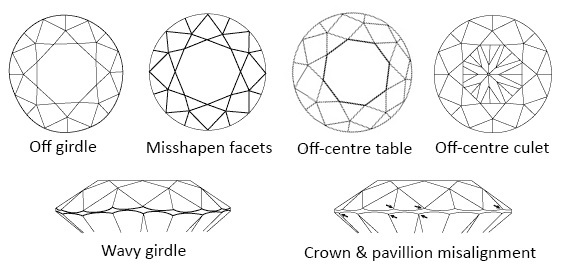
Does Symmetry Impact on the Appearance of a Diamond?
Yes. A diamond with poor symmetry can look misbalanced and have an affect (albeit a small one), on light performance. If your diamond is asymmetrical, it will not have the desired sparkle. It is also important to consider symmetry when looking at fancy shaped diamonds as asymmetrical diamonds or diamonds with bad symmetry can fail to meet the basic criteria for their intended shape (such as heart, marquise etc).
However, like all aspects of diamond quality, a symmetry grading should be read within the context over the overall cut grade and indeed the entire grading report. A diamond that is dull, lacklustre and badly cut may still hold a symmetry grading of Excellent even though the overall cut grade is much lower.
Polish and Symmetry in Super Ideal Hearts & Arrows Diamonds
When it comes to hearts and arrows diamonds, an excellent polish, cut and symmetry are all required in order to create the precise patterning that defines a true hearts and arrows diamond. The requirements for a hearts and arrows diamond are even more stringent than those set for an Excellent cut diamond; this means a diamond with an Excellent grade will usually not be a hearts and arrows diamond – only around 1-2% will be!
The Final Word
So, should you choose a diamond based on an Excellent polish and symmetry grades? Polish and symmetry should just be the foundation of your diamond search, without good polish and symmetry your diamond won’t have the best brilliance and sparkle so this should absolutely be considered in your search however it should not be the only criteria that you consider. Light performance however is also heavily influenced by the diamond’s crown angles, table size/depth and pavilion angles. If a diamond achieves excellent symmetry and polish, it can still appear dull if the crucial proportions are cut wrongly.
If you are looking for the best performing super ideal cut diamonds then the Whiteflash signature A CUT ABOVE® diamonds should be your first choice, I would then also consider the Blue Nile Astor Collection.

Richard Jenkins, The Diamond Guru
Get free assistance from the Diamond Guru today. You’ll be glad you did!
- Secure the best quality diamond for your budget.
- Don’t pay over the odds for your diamond ring.
- Have peace of mind that you didn’t get ripped off.
Have a Question? Contact us now…

